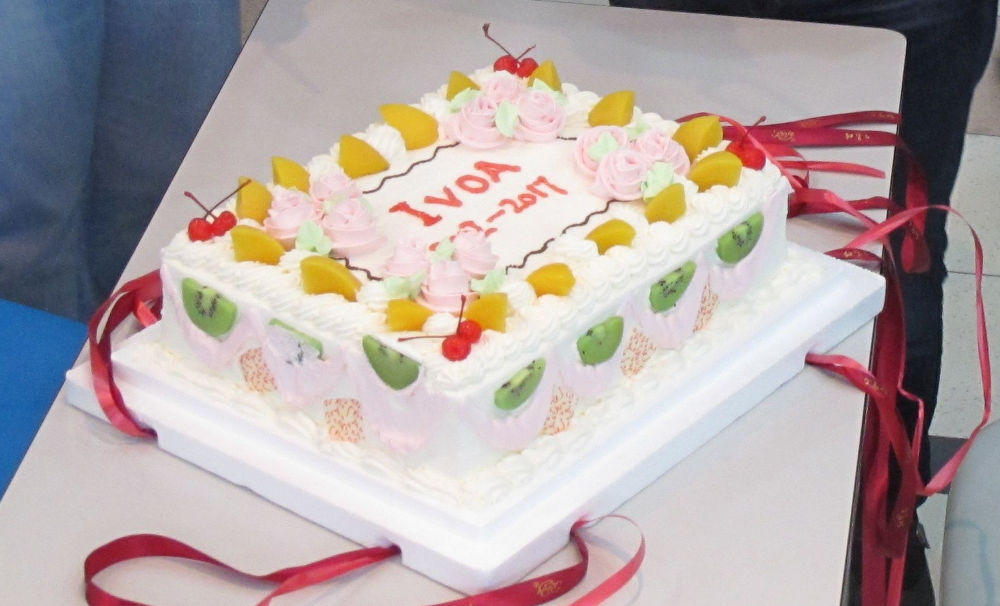
15 Years of IVOA: The birthday cake our Shanghai hosts prepared for us.
Every half year, VO enthusiasts from all over the world gather for an “Interoperability conference”, or Interop for short. The latest such event, the Shanghai Interop 2017, ended Friday a week ago. It has been a “long” one again after the short southern spring Interop in Trieste last year (featured in this blog).
As usual, it was a week of many discussions and much consensus-building. In this post, I'd like to mention a few of the GAVO-related contributions; links typcially go to slides or lecture notes PDFs.
On the Registry side of things, we're currently (among many other things) briding the gap between DOIs and the Registry in VOResource 1.1, and we invited registry providers to take up the new features, as well as proposing how to update RegTAP (which is used to actually query the Registry) to cope with the new metadata.
Also in Registry, our efforts of almost a decade to properly support registering tables and similar data collections bore fruit (Britain's Mark Taylor reported on his experiences taking up our current proposal), and the fairly spectacular new Aladin V10 (presented by the CDS' Pierre Fernique, who showed off what I'm tempted to call a “visual registry interface”) urgently needs what we've developed over the years.
We furthermore reported on new steps to finally let people search the registry using Space-Time constraints (spoiler: the tech is almost there, registry records need lots of work).
Spatial searches in the registries are one thing enabled by storing and searching for MOCs in relational databases, as was reported by Markus Nullmeier over in an Applications session. The setting may already tell you that these MOCs (Multi Order Coverages, a healpix-based way of representing fairly arbitrary areas on the sky) have applications far beyond Registry.
Also in Apps, Ole reported on progress in packaging VO applications for easy and reliable installation, in this case for Debian and derivatives. Finally for Apps, Margarida reported on getting lines and line lists into the spectral analysis package SPLAT: Implementation of SLAP and VAMDC interfaces in SPLAT-VO.
In the wider area of data access protocols and underlying data models, we contributed to Marco's talk on the long-overdue facelifting for the VO's bedrock, Simple Cone Search (Keeping SCS up-to-date within DAL landscape) – the fact that there's an installed base of 15000 of such services may let you guess that we need to tread lightly here. On the bleeding-edge side of things, we presented our current ideas on how, eventually, several data models, data modelling as such and the annotation of data according to these data models might play together in publishing time domain data with DACHS (previously featured on this blog in a slightly less technical way).
We also talked about education and outreach. Hendrik reported on our ADQL course and how it helps future astronomers learn dealing efficiently with even very large datasets. Hendrik's long-lasting dedication to these topics did not go unpunished at this interop: since the Exec meeting on the Interop Wednesday he is vice-chairing the education interest group of the IVOA. Back in the session I also mused a bit about what metadata changes are needed to make the VO tutorial collection VOTT more useful.
It is a particular pleasure for me to mention that the IVOA has a new interest group: “Solar System”. Regular readers of the blog will have noticed that I have a particularly soft spot in my heart for that crowd, and so I gave a short overview over how DaCHS is used among them, too.
And that's just the official programme. Much more fixing, designing, and discussion went on between sessions or in the evenings. The latter, of course, included some decidedly less technical aspects. Including, as pictured above, a nice birthday cake for the IVOA, as it is now 15 year since the first Interop meeting in January 2002.

![[RSS]](./theme/image/rss.png)